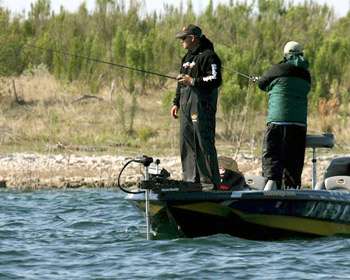
For many bass anglers, boat ramps represent nothing more than an access point to the lake — and maybe a source of anxiety on crowded weekends. Elite Angler Kurt Dove, however, sees ramps as much more than the starting and ending point of his fishing day.
They can also be the ticket to a productive day on the water. "It doesn't really matter whether it is spring, fall, summer, or winter, you are always going to find bass around boat ramps," declares Dove, a former east coast angler who recently relocated to Texas.
Dove looks for four key features to determine whether a ramp will be good or great: launch activity, docks, riprap and structure. While the presence of a single ingredient may hold several bass, ramps that contain all four often prove to be the sweetest combination. Here's a breakdown on how Dove approaches fishing a boat ramp:
Ramp Activity — Determining ramp activity often requires a little off-the-water research that can pay big dividends. "The very first thing I look at is whether or not there are any tournaments that use that ramp for weigh-ins," explains Dove. "Typically, with any boat ramp where there are tournaments, you're going to find bass in the area." While many larger tournament circuits use holding tanks to redistribute bass throughout the lake after the tournament day is competed, smaller tournaments often just release bass right at the ramp after weigh in.
These bass are commonly known as "release fish." "I can think of several occasions when I've done really well just focusing on ramps. I typically do a lot better in the morning, especially when I'm fishing for release fish," says Dove. "Those bass seem to be almost like pet fish because people on the dock feed them (unused minnows). But in the morning, they are really vulnerable to artificial offerings."
Docks — After determining the ramp's popularity for weigh-ins, Dove next looks for docks surrounding the ramp. Dove goes through a mental checklist to assess which docks will be most effective. How close are the docks to the ramp? What kind of docks are they?
What structure exists around each dock? "The type of dock will usually dictate some of the baits that I'm going to use," explains Dove. "If it's a floating dock, I may want to swim a jig around the sides because the bass are most likely suspended under the dock. If it's a fixed dock, built on poles, I'll be more likely to use some sort of Texas rigged plastic and focus on the poles."
Time of day and conditions also play into Dove's dock decision. In the afternoon, when the sun gets high, launch areas with docks provide better cover. "In that situation, you can continue to catch fish on boat ramps throughout the day," he notes.
Riprap — The third ingredient that Dove looks for is the presence of riprap or chunk rock adjacent to the boat ramp. In many cases, the surrounding bank is lined with big rocks to reduce erosion and protect the integrity of the original bank. Keying on long stretches of riprap that extend all the way to the ramp is often a productive pattern. "A lot of times, those bass will really relate to stretches of riprap that continue out into the water around the ramp," says Dove.
His favorite techniques when focusing on these rocky stretches are fast moving baits cast parallel to the bank and worked over the chunk rock. "I really like to fish crankbaits cast right along the side of the rock bank," relates Dove. "It's difficult to fish with a Texas rig because the sinker often gets hung up in rock crevices. But a crankbait or a swimbait tends to do really well in those areas."
Ramp Structure — The final thing he likes to find is a little more difficult to see, but it exists at the majority of well used ramps. "What I'm looking for is a hole where the concrete ends," Dove explains. "There usually is some 'blowout' created when a boater runs his engine to load his boat on a trailer. The prop wash creates little depressions at the end of the ramp."
Besides focusing on the depressions caused by props, Dove also takes the time to find the actual edge of the concrete slab where the ramp ends and meets the natural lake bottom. He has found that the bass will relate to the abrupt edge and ambush baitfish and prey in the area. When fishing ramps without docks during the midday hours, Dove believes that underwater structure becomes the dominant reason bass will remain in the area.
"You really have to look at the ramp and decipher what you are fishing. If rocks that line the ramp run way out into the water, you'll want to key on that deeper structure later on in the day, rather than fishing right up on the bank." The next time you back a boat into the water at your favorite bass lake, look for these key ingredients of prime boat ramps.
If you find them, you might do well to make a few casts before firing up the outboard. The ramp might just be your launching point for a memorable day on the water.
(Provided by Z3 Media)




